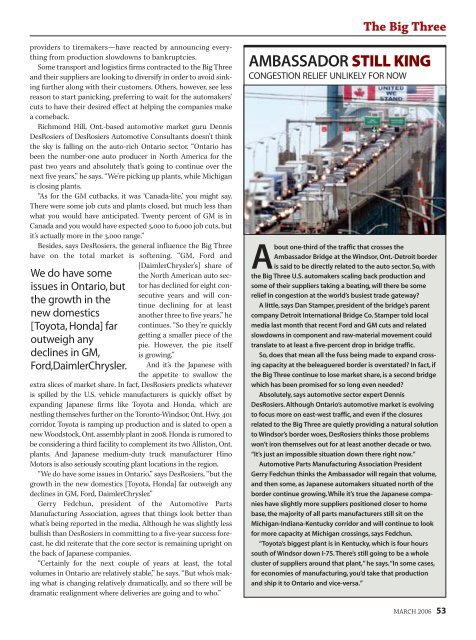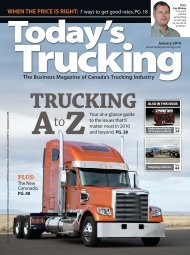Create successful ePaper yourself
Turn your PDF publications into a flip-book with our unique Google optimized e-Paper software.
providers to tiremakers—have reacted by announcing everything<br />
from production slowdowns to bankruptcies.<br />
Some transport and logistics firms contracted to the Big Three<br />
and their suppliers are looking to diversify in order to avoid sinking<br />
further along with their customers. Others, however, see less<br />
reason to start panicking, preferring to wait for the automakers’<br />
cuts to have their desired effect at helping the companies make<br />
a comeback.<br />
Richmond Hill, Ont.-based automotive market guru Dennis<br />
DesRosiers of DesRosiers Automotive Consultants doesn’t think<br />
the sky is falling on the auto-rich Ontario sector. “Ontario has<br />
been the number-one auto producer in North America for the<br />
past two years and absolutely that’s going to continue over the<br />
next five years,” he says. “We’re picking up plants, while Michigan<br />
is closing plants.<br />
“As for the GM cutbacks, it was ‘Canada-lite,’ you might say.<br />
There were some job cuts and plants closed, but much less than<br />
what you would have anticipated. Twenty percent of GM is in<br />
Canada and you would have expected 5,000 to 6,000 job cuts, but<br />
it’s actually more in the 3,000 range.”<br />
Besides, says DesRosiers, the general influence the Big Three<br />
have on the total market is softening. “GM, Ford and<br />
We do have some<br />
issues in Ontario, but<br />
the growth in the<br />
new domestics<br />
[Toyota, Honda] far<br />
outweigh any<br />
declines in GM,<br />
Ford,DaimlerChrysler.<br />
[DaimlerChrysler’s] share of<br />
the North American auto sector<br />
has declined for eight consecutive<br />
years and will continue<br />
declining for at least<br />
another three to five years,” he<br />
continues. “So they’re quickly<br />
getting a smaller piece of the<br />
pie. However, the pie itself<br />
is growing.”<br />
And it’s the Japanese with<br />
the appetite to swallow the<br />
extra slices of market share. <strong>In</strong> fact, DesRosiers predicts whatever<br />
is spilled by the U.S. vehicle manufacturers is quickly offset by<br />
expanding Japanese firms like Toyota and Honda, which are<br />
nestling themselves further on the Toronto-Windsor, Ont. Hwy. 401<br />
corridor. Toyota is ramping up production and is slated to open a<br />
new Woodstock, Ont. assembly plant in 2008. Honda is rumored to<br />
be considering a third facility to complement its two Alliston, Ont.<br />
plants. And Japanese medium-duty truck manufacturer Hino<br />
Motors is also seriously scouting plant locations in the region.<br />
“We do have some issues in Ontario,” says DesRosiers, “but the<br />
growth in the new domestics [Toyota, Honda] far outweigh any<br />
declines in GM, Ford, DaimlerChrysler.”<br />
Gerry Fedchun, president of the Automotive Parts<br />
Manufacturing Association, agrees that things look better than<br />
what’s being reported in the media. Although he was slightly less<br />
bullish than DesRosiers in committing to a five-year success forecast,<br />
he did reiterate that the core sector is remaining upright on<br />
the back of Japanese companies.<br />
“Certainly for the next couple of years at least, the total<br />
volumes in Ontario are relatively stable,” he says. “But who’s making<br />
what is changing relatively dramatically, and so there will be<br />
dramatic realignment where deliveries are going and to who.”<br />
The Big Three<br />
AMBASSADOR STILL KING<br />
CONGESTION RELIEF UNLIKELY FOR NOW<br />
About one-third of the traffic that crosses the<br />
Ambassador Bridge at the Windsor, Ont.-Detroit border<br />
is said to be directly related to the auto sector. So, with<br />
the Big Three U.S. automakers scaling back production and<br />
some of their suppliers taking a beating, will there be some<br />
relief in congestion at the world’s busiest trade gateway?<br />
A little, says Dan Stamper, president of the bridge’s parent<br />
company Detroit <strong>In</strong>ternational Bridge Co. Stamper told local<br />
media last month that recent Ford and GM cuts and related<br />
slowdowns in component and raw-material movement could<br />
translate to at least a five-percent drop in bridge traffic.<br />
So, does that mean all the fuss being made to expand crossing<br />
capacity at the beleaguered border is overstated? <strong>In</strong> fact, if<br />
the Big Three continue to lose market share, is a second bridge<br />
which has been promised for so long even needed?<br />
Absolutely, says automotive sector expert Dennis<br />
DesRosiers. Although Ontario’s automotive market is evolving<br />
to focus more on east-west traffic, and even if the closures<br />
related to the Big Three are quietly providing a natural solution<br />
to Windsor’s border woes, DesRosiers thinks those problems<br />
won’t iron themselves out for at least another decade or two.<br />
“It’s just an impossible situation down there right now.”<br />
Automotive Parts Manufacturing Association President<br />
Gerry Fedchun thinks the Ambassador will regain that volume,<br />
and then some, as Japanese automakers situated north of the<br />
border continue growing. While it’s true the Japanese companies<br />
have slightly more suppliers positioned closer to home<br />
base, the majority of all parts manufacturers still sit on the<br />
Michigan-<strong>In</strong>diana-Kentucky corridor and will continue to look<br />
for more capacity at Michigan crossings, says Fedchun.<br />
“Toyota’s biggest plant is in Kentucky, which is four hours<br />
south of Windsor down I-75. There’s still going to be a whole<br />
cluster of suppliers around that plant,” he says.“<strong>In</strong> some cases,<br />
for economies of manufacturing, you’d take that production<br />
and ship it to Ontario and vice-versa.”<br />
MARCH 2006 53



